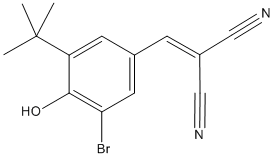All AbMole products are for research use only, cannot be used for human consumption.

AG1024 (Tyrphostin AG 1024) is a reversible, competitive and selective IGF-1R inhibitor with an IC50 of 7 μM. AG1024 inhibits phosphorylation of IR (IC50=57 μM). Tyrphostin AG 1024 prevents the growth inhibition for IC20 plus irradiation (4 Gy) by 50% compared to the control.Examination of Tyrphostin AG 1024 effects on radiation response demonstrates a marked enhancement in radiosensitivity and amplification of radiation-induced apoptosis. Tyrphostin AG 1024-induced apoptosis is associated with a downregulation of expression of phospho-Akt1, increased expression of Bax, p53 and p21, and a decreased expression of bcl-2 expression, especially when combined with irradiation. Tyrphostin AG 1024 is an effective anti-proliferative agent for breast carcinoma cells MCF-7. IGF1-R inhibitor tyrphostin AG1024 (10 μm) restores H358 cells apoptosis when cultured in serum-free medium. Incubation with AG1024 markedly decreases the AR level detected in the serum-free culture medium. AG1024 reduces IGF1 release in the serum-free culture medium. AG1024 enhances the apoptosis-inducing effect of gefitinib. Tyrphostin AG1024 significantly inhibits signal transmission by Akt (PKB), ERK (1/2), Src and STAT.The cytotoxic effect of AG1024 is more than 100 times greater on nutrient-deprived PANC-1 cells (NDM) with an IC50 of 55 nM, relative to cells in nutrient-sufficient medium (DMEM) with an IC50 of 21 μM. In DMEM, 0.3 μM AG1024 does not induce any significant PANC-1 cell death as determined using propidium iodide and annexin V staining and flow cytometry. In contrast, 34% of the cells grown in NDM and treated with the same concentration of AG1024 reveals propidium iodide-positive/annexin V-negative staining. In addition, AG1024 gives rise to significant increases in neuronal ADDL binding both when AG1024 is added alone and in the presence of exogenous insulin.
| Cell Experiment | |
|---|---|
| Cell lines | MCF-7 |
| Preparation method | Cells are exposed to AG-1024 for 24, 48 or 72 hours. For the determination of proliferation, cells are harvested and counted with trypan blue dye exclusion. Apoptosis is evaluated by dual staining of MCF-7 with fluoresceine anti-digoxigenin and propidium iodide. Briefly, fixed cells are washed with PBS, suspended in TdT buffer with TdT enzyme and Dig-dUTP for 60 minutes, and suspended in FITC blocking solution with anti-Dig-Fluorescein for 30 minutes at room temperature and kept in a dark place. Cells are then rinsed in buffer and resuspended in propidium iodide/RNase A solution for 30 minutes then analyzed by flow cytometry. For the assessment of phospho-Akt1, Bax, p53, bcl-2 and p21, cells are lysed and analyzed by western blot. |
| Concentrations | Dissolved in DMSO, final concentration 10 μM |
| Incubation time | 24, 48 or 72 hours |
| Animal Experiment | |
|---|---|
| Animal models | Female nude mice implanted subcutaneously with Ba/F3-p210 cells |
| Formulation | Dissolved in DMSO, and diluted in PBS |
| Dosages | 30 μg/day |
| Administration | Injected i.p |
| Molecular Weight | 305.17 |
| Formula | C14H13BrN2O |
| CAS Number | 65678-07-1 |
| Solubility (25°C) | DMSO 50 mg/mL |
| Storage |
Powder -20°C 3 years ; 4°C 2 years In solvent -80°C 6 months ; -20°C 1 month |
[4] Maria Laura Giuffrida, et al. Beta-amyloid monomers are neuroprotective
[5] B Wen, et al. Tyrphostin AG 1024 modulates radiosensitivity in human breast cancer cells
| Related IGF-1R Products |
|---|
| Indirubin Derivative E804
Indirubin Derivative E804 is a potent inhibitor of Insulin-like Growth Factor 1 Receptor (IGF1R), with an IC50 of 0.65 μM for IGF1R. |
| IGF-I (24-41)
IGF-I (24-41) (Insulin-like Growth Factor I (24-41)) is amino acids 24 to 41 fragment of IGF-I. |
| GIP, human
GIP, human is a peptide hormone consisting of 42 amino acids that also acts as a promoter of glucose-dependent insulin secretion and a weak inhibitor of gastric acid secretion. In addition, GIP, human acts as an enteric proinsulin hormone released by intestinal K cells in response to nutrient intake. |
| VMB-100
VMB-100 is an engineered mRNA molecule encoding human insulin-like growth factor-1 (IGF-1) that induces IGF-1 expression in human muscle cells. |
| NBI-31772 hydrate
NBI-31772 hydrate is a potent inhibitor of interaction between insulin-like growth factor (IGF) and IGF-binding proteins (IGFBPs). NBI-31772 hydrate is also a nonpeptide ligand that releases bioactive IGF-I from the IGF-I/IGFBP-3 complex (Kis=1-24 nM for all six human subtypes). Anxiolytic and antidepressant-like effects. |
All AbMole products are for research use only, cannot be used for human consumption or veterinary use. We do not provide products or services to individuals. Please comply with the intended use and do not use AbMole products for any other purpose.


Products are for research use only. Not for human use. We do not sell to patients.
© Copyright 2010-2024 AbMole BioScience. All Rights Reserved.
